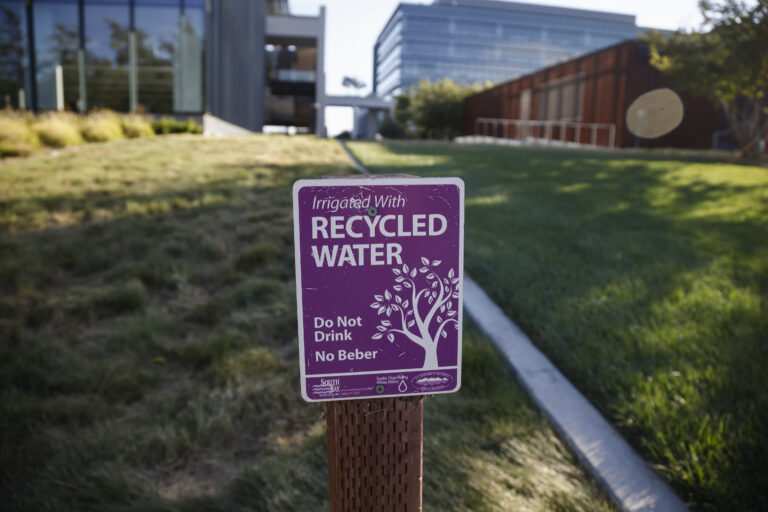
California’s most-recent drought is over. Reservoirs are full. Ski season lasted until July.
But despite the wet winter, an effort is gaining momentum in the state capitol to add manicured green grass to the list of business trappings — like fax machines, pagers and typewriters — that have become obsolete in a changing world.
During California’s three-year drought, state water regulators banned watering “ornamental turf” at corporate, industrial or government properties with potable water as a way to preserve supplies. That emergency regulation is set to expire next June.
A new bill would make the ban permanent. Under the measure, AB 1572, it would be illegal for businesses like office parks, car dealerships, supermarkets, strip malls, or corporate campuses to water decorative grass with drinkable water — whether or not California is in a drought. Scofflaws would face fines of up to $500 a day.
The prohibition also would apply to factories, industrial sites and public use properties, like road medians, churches, schools and universities, statewide. The rules would not apply to lawns at residential homes, apartment buildings, cemeteries or any “functional turf” that has a recreational use, including sports fields, golf courses, playgrounds, pet exercise areas and picnic grounds.
The bill passed the state Assembly by a vote of 55-18 on May 31 and is now moving through the state Senate.
Supporters note that California has had three severe droughts since 2007, and as the climate continues to warm, they say it doesn’t make sense to use drinking water on decorative lawns — a landscape that people don’t eat or use.
“Droughts are not behind us,” said Assemblywoman Laura Friedman, D-Burbank, the author of the measure. “This bill is looking at some of the lowest-hanging fruit, grass that’s purely ornamental and uses a lot of drinking water. We should be more thrifty.”
The measure is supported by a long list of environmental groups, including the Natural Resources Defense Council, Sierra Club California and Defenders of Wildlife. It gained political momentum recently after winning the endorsement of some of the state’s largest water agencies, including the influential Metropolitan Water District of Southern California, and the Santa Clara Valley Water District.
Critics, however, say new lawn limitations don’t reflect that California is a huge state, with different water sources and weather conditions from Eureka to Palm Springs.
“This was something that was meant for an emergency when we were in the midst of a drought,” said James Gallagher, the Republican Assembly leader who represents Yuba City. “That’s not always the case. To make it a permanent part of our law I don’t think is the right approach.”
Gallagher said California should leave most water decisions, particularly in nondrought years, up to local officials. He also said state leaders like Gov. Gavin Newsom have not done enough to build new reservoirs and increase water storage.
“Whether it comes to energy, water or other resources, their strategy is to keep us in permanent scarcity,” Gallagher said. “Maybe that’s because it gives them the ability to have control. But emergency powers should be used in limited circumstances when there is an emergency.”
Several major business groups, including the California Chamber of Commerce, at first opposed the bill. But after Friedman made changes to remove apartment complexes, clarify which properties were exempt, and phase in rules, which would begin Jan. 1, 2027, they dropped their opposition.
“We have some members who are really squawking about it. There’s some concern. But we aren’t actively fighting the bill,” said Matthew Hargrove, president and CEO of the California Business Properties Association.
Hargrove noted that under former Gov. Jerry Brown, state regulators began cracking down on urban water use during the 2012-16 drought, which caused many office parks and other commercial properties to install water-efficient landscaping. City and state building codes already require water-efficient plants and trees to get permits for most new construction.
“Most of the large properties are already doing this stuff,” Hargrove said. “Well-managed properties try to be energy efficient and water efficient. Just like with energy, water is a big expense. It’s a cost issue for us.”
Other major business groups also are neutral, including the Silicon Valley Leadership Group and the Bay Area Council.
“The writing has been on the wall. The days of ornamental turf have been numbered for a while now,” said Adrian Covert, senior vice president for the Bay Area Council.
The bill would allow decorative lawns to remain at commercial, industrial and government sites if they use recycled water.
Exactly how much water would be saved is hard to quantify. Few cities and water districts are enforcing the existing emergency ban. Some, like Morgan Hill, already have passed local laws to ban watering of decorative turf with potable water.
A study last year by the nonprofit Pacific Institute in Oakland found that 44% of all urban water used in California, or 2.8 million acre-feet, is used outdoors, mostly for landscape irrigation. Of that, at least 340,000 acre-feet — enough for 850,000 people a year — could be saved if commercial, industrial and government properties used more water-efficient landscaping, the research group found.
Last year, Nevada lawmakers passed a similar ban for Las Vegas. The city of Albuquerque is considering one.
“This is sort of a trend we are seeing across the West as we grapple with a hotter, drier future,” said Heather Cooley, director of research at the Pacific Institute.
“It’s about stretching our water supply and making it more resilient,” she said. “If we make these changes now we can continue to have green spaces, just not lawns everywhere.”
___
© #YR@ MediaNews Group, Inc
Distributed by Tribune Content Agency, LLC.
0 comments :
Post a Comment